March 13, 2009
Air Date: March 13, 2009
FULL SHOW
SEGMENTS
Cap and Trade by Numbers
View the page for this story
President Obama has called for a cap and trade system to limit the greenhouse gas emissions that cause climate change. Host Bruce Gellerman asks Professor Robert Stavins, director of the environmental economics program at Harvard’s Kennedy School of Government, for a primer on how the environment and people can profit from pollution. (06:00)
Political Will and the Climate Change Bill
/ Jeff YoungView the page for this story
Congress is girding for a bruising political battle over global warming. But the toughest fight might not be between Democrats and Republicans but rather between Democrats and Democrats. Living on Earth's Jeff Young tells us why some centrist Democrats from the heartland have problems with President Obama's call for action on climate change. (06:00)
Science on Hold
View the page for this story
Despite President Barack Obama's recent focus on science, his two nominees for high-profile science positions are stuck in Senate limbo. Anonymous Senators have put holds on the confirmation of Jane Lubchenco, picked to head the National Oceanic and Atmospheric Administration, and John Holdren, chosen as the president's special assistant for science and technology. The delay is bad for President Obama and for Americans, says Francesca Grifo, a senior scientists with the Union of Concerned Scientist. (03:10)
Mapping Climate Change
/ Bruce GellermanView the page for this story
Satellites play a critical role in monitoring and preserving the world’s tropical forests. The eyes in the sky have revolutionized our world view but they may not be up to the task in the future. Host Bruce Gellerman looks at the future of remote earth sensing satellites. (08:00)
CO2-Eating Rocks
View the page for this story
One geologist thinks he has the answer for storing massive amounts of carbon dioxide: turn it into the stuff of seashells. The idea is to use a rock found in the Earth that absorbs the greenhouse gas. Host Bruce Gellerman speaks with scientist Juerg Matter of Columbia University’s Earth Institute. (05:10)
Listener Letter
View the page for this story
Living on Earth dips into our mailbag to hear from listeners. (02:00)
Cartoon with a Message
View the page for this story
Artists sometimes use their medium to send a message. Cartoonist Jim Toomey’s are in a bottle. His syndicated comic strip “Sherman’s Lagoon” has a cast of aquatic characters who live in the South Pacific and ponder environmental issues about the ocean. Toomey tells host Bruce Gellerman about how he uses humor to educate his readers. (06:45)
Worm Grunters
/ Peter WhiteView the page for this story
For generations, the Revell family has gone into the Apalachicola National Forest in Florida to collect bait worms using a technique called worm grunting. With a stake and metal bow in hand, they make vibrations in the ground and cause worms to rise to the surface by the thousands. Reporter Peter White went with the Revells on a recent early morning to find out how this technique works. (06:15)
This week's EarthEar selection
listen /
download
Show Credits and Funders
Show Transcript
Host: Bruce Gellerman
Guests: Francesca Grifo, Juerg Matter, Robert Stavins, Jim Toomey
Reporters: Bruce Gellerman, Peter White, Jeff Young
[THEME]
GELLERMAN: From Public Radio International - this is Living on Earth.
[THEME]
GELLERMAN: I’m Bruce Gellerman.
Coming up: Want to buy a ton of carbon dioxide? It may be invisible and odorless - but it could have the smell of money:
STAVINS: The good news is that people can potentially make money off of reducing pollution. That’s how you can harness market forces to protect the environment.
GELLERMAN: How to cash in on carbon dioxide - and the value of radar images from space. A climate scientist counts the many waves.
KELLNDORFER: From long to short wavelengths…it’s p-l-c-x…and I call it peter loves claudia’s xylophone.
GELLERMAN: And environmentalists love new satellite sensors.
Also grunting – music to the ears of worms?
[SOUND OF POUNDING AND GRUNTING]
GARY: Once you make the right music, they’ll go to dancing for you. Hopefully, I’m doing it. (LAUGHS)
GELLERMAN: The dirt on earthworms - and more - this week on Living on Earth! Stick around.
[NEWSCAST MUSIC: Boards Of Canada “Zoetrope” from “In A Beautiful Place Out In The Country” (Warp Records 2000)]
ANNOUNCER: Support for Living on Earth comes from the National Science Foundation and Stonyfield Farm.
[THEME]
Cap and Trade by Numbers
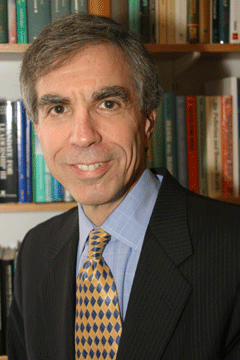
Robert Stavins, director of the Harvard Environmental Economics Program at the JFK School of Government.
GELLERMAN: From the Jennifer and Ted Stanley Studios in Somerville, Massachusetts - this is Living on Earth. I’m Bruce Gellerman, in for Steve Curwood.
In the coming weeks and months you’ll be hearing a lot about “cap and trade”. The President is counting on it to help bail out the budget and save the planet. Cap and trade is a scheme for buying and selling the right to emit carbon dioxide. It allows the marketplace to put a price on that pollution, aiming to reduce the greenhouse gas over time. Cap and trade has been used successfully before. It sharply limited acid rain and smog.
Professor Robert Stavins is director of the Harvard Environmental Economics Program at the JFK school of Government. And he says cap and trade has a lot going for it.
STAVINS: Well, the good news is that people can potentially make money off of reducing pollution. That’s how you can harness market forces to protect the environment. So that’s actually the good news of these approaches is that it provides opportunity for people to make money, as long as it’s done in legitimate ways.
GELLERMAN: Well, let’s go through cap and trade. Let’s start with the cap.
STAVINS: So the cap is set to limit pollution overall, much as it is with any kind of environmental regulation.
GELLERMAN: So you say to a producer of carbon dioxide, you can only produce this amount and no more.
STAVINS: Well the cap doesn’t refer importantly to individual producers. It refers to the economy as a whole. So the cap might provide that emissions are going to be reduced this year by two percent, and the next year by two percent, over time by, in fact, 80 percent. That’s the cap and it’s across the entire sector or even the entire economy.
GELLERMAN: And the trade?
STAVINS: And the trade is that individual firms under the cap have each been allocated allowances – big political question of how they’re allocated – and then they are free to trade, but they can only emit as much pollution as the allowance says. And if you add up all those allowances, all the tons in the allowances, that’s equal to the cap. And the cap is declining over time.
GELLERMAN: So it’s seems that another name for cap and trade might be carrot and stick or maybe stick and carrot.
STAVINS: I think that that’s absolutely right. The carrot is that it is going to cost something to some firms and can benefit others to engage in a trade, so there are gains from trade. And the stick that no one should forget is that monitoring and enforcement is required; both of the emissions themselves or the carbon use, and for that matter also of the allowance trading system.
GELLERMAN: So private industry is not too happy about this because they gotta buy these things.
STAVINS: Well there’s tremendous support within private industry for the cap and trade approach in general because they see regulation coming and it’s the lowest cost approach for them. There is not widespread support for the auctioning of the allowances, because when the allowances are auctioned it means private industry pays not only to their control costs, but they also pay for the right to emit.
GELLERMAN: Well the Obama administration is literally banking on this money. How much money are we talking about?

Robert Stavins, director of the Harvard Environmental Economics Program at the JFK School of Government.
STAVINS: Well the Obama administration in its recent budget projected that they would obtain revenues on the order of 750 to 800 billion dollars over a period of close to a decade from the auction of the allowances, from selling the allowances to private industry.
GELLERMAN: Would I be able to buy one of these allowances?
STAVINS: Well, that’s interesting because under the way at least the previous statutes had been written for the SO2 allowance trading program, whether or not you are regulated by the program – in that case an electricity generator – you can buy an allowance. And, in fact, under the SO2 allowance trading program you can go to the EPA website and see this – a substantial number of the purchases of allowances have been by student groups. And they take that allowance, and you know what they do with it? They tear it up. And something remarkable happens when an individual citizen buys an allowance in cap and trade program and tears it up or hides it. They have actually made more stringent the overall cap that was enacted by the Senate, the House of Representatives and signed by the President.
GELLERMAN: Because they’ve reduced the number of shares.
STAVINS: That’s right. That’s right. And it’s remarkable. I mean, frankly, I don’t know of any other public policy in any sphere where an individual citizen through their actions can actually render more stringent a policy enacted by the Congress.
GELLERMAN: So, can it reduce the greenhouse gas? It may work in the marketplace, buying and selling, but will it actually reduce greenhouse gases?
STAVINS: If the cap is set to bring down the level of CO2 and or other greenhouse gases over time, then as long as monitoring and enforcement is working, then it will definitely work. And our experience with these programs is that they work. Compliance with the acid rain the SO2 allowance trading program is about 99.9 percent.
GELLERMAN: But what about capping and trading things like leaving the fossil fuel in the ground?
STAVINS: Well essentially that’s what’s happening. That’s an interesting point. I mean, essentially what happens with a cap and trade system is that it increases the cost of bringing coal, for example, into the economy. In fact, many people have said that a meaningful carbon policy is essentially a tax on coal, because that’s what they really become because of the great carbon intensity of coal compared to the other fossil fuels. And indeed a meaningful cap and trade program such as the one the administration has described will indeed discourage production of coal with one very important exception – and that’s the possibility of technologies being developed for carbon capture and storage, that is using coal to generate electricity, capturing the stack gases, separating out the carbon dioxide, liquefying it, and putting it underground in storage. There are a lot of chains in that very long sentence and there’s a lot of technological uncertainty.
GELLERMAN: Yeah, holy grail.
STAVINS: Well it’s certainly the holy grail for the coal industry and for many electricity generators who are highly reliant upon coal.
GELLEMAN: Professor Robert Stavins is director of the Harvard Environmental Economics Program and the JFK School of Government. Professor, thank you for coming in.
STAVINS: My pleasure.
Related link:
For more on Robert N. Stavins, click here
Political Will and the Climate Change Bill

Senator Claire McCaskill (Courtesy of the U.S. Senate)
GELLERMAN: Well, as good as it may sound, Cap and Trade is far from a done deal. President Obama proposes but Congress may not feel disposed - especially moderate Democrats from heartland states, who are cool to action on global warming that could harm industries in their districts.
Living on Earth’s Washington correspondent Jeff Young is keeping tabs on the political climate for a climate change bill - and has our report.
YOUNG: California Democrat Henry Waxman put the environment at the center of his 35 years in Congress. Now as chair of the powerful House Energy committee Waxman is at the center of efforts on the planet’s biggest environmental threat. He’ll push a strong cap and trade bill on climate change through his diverse and sometimes fractious committee.
WAXMAN: Our committee is an interesting committee. Our committee represents the whole House. A bill that will emerge from our committee is a bill that I think can pass the House and may well be a model for the Senate, but don’t tell them I said that, [laughter] ‘cause they’ll want to do their own bill. And that’s fine, too.
YOUNG: The founding fathers devised the Senate as the “cooling saucer” in lawmaking, and that’s where a global warming bill might get the chilliest reception.

Senator Claire McCaskill (Courtesy of the U.S. Senate)
Yes, Waxman has some strong allies in the Senate eager to tackle climate change, and many will likely introduce bills of their own. But a list of those supporters reads like a trip along the country’s coasts. What’s missing is a big chunk of the heartland. Geography, not party, determines a Senator’s stance on energy. And a bloc of centrist democrats from the industrial Midwest and coal-dependent south could well hold the key.
[HALLWAY SOUNDS]
YOUNG: Last month, on the night President Obama called on Congress to cap carbon emissions, I sought out the Senators known as the “gang of 15”. Some of them sent a letter last year to Democratic leaders laying out reasons they could not support climate change legislation. And the group has grown. They’re people like Senator Mark Warner of Virginia.
WARNER: I support dealing with climate change. You know the devil is going to be in the details.
YOUNG: And Senator Claire McCaskill of Missouri.
MCASKILL: Yes of course I want to support a climate change bill but the devil is in the details.
YOUNG: And Sen. Kent Conrad of North Dakota who says, you guessed it:
CONRAD: Uh, devil’s in the details.
YOUNG: What are those devilish details? They boil down to two main points: competition from China, and energy from coal. In Missouri, about 80 percent of the electricity comes from coal, the most carbon heavy fossil fuel. Missouri Senator McCaskill fears dramatic rate increases if power plants aren’t allowed time to reduce carbon emissions.
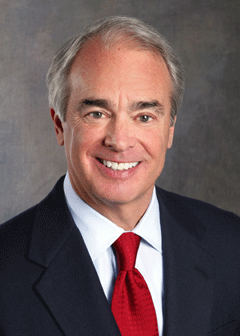
(Courtesy of Duke Energy)
YOUNG: But carbon capture might be a decade away. Does that mean we wait a decade before we address climate change? Scientists tell us we don’t have that much time.
MCCASKILL: Oh no, we have to address climate immediately and we will. I just think we’ve got to find that sometimes elusive middle ground.
YOUNG: There are widely varying economic analyses of what a cap and trade bill might mean for energy costs. McCaskill’s concern about rates doubling or tripling is far higher than what most economists project. Senator Evan Bayh represents another coal dependent state, Indiana. He worries about additional costs for businesses already suffering from the economic downturn and foreign competition.
BAYH: If we’re going to really bite the bullet here and make progress as I believe we must, we’ve got to find a way to get China and India and the other rapidly developing countries involved. Because to ask the American people to sacrifice and then have that sacrifice go for naught is not the outcome we need.
YOUNG: The senators have a lot to think about, and an army of lobbyists is there to help.
The nonpartisan think tank Center for Public Integrity found more than 2300 lobbyists working on the issue. That’s four lobbyists for every member of Congress, and most work for fossil fuel industries.
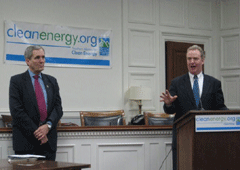
Rep. Lloyd Dogget at a press event supporting 100 percent auctioning of carbon credits. (Courtesy of the Southern Alliance for Clean Energy)
ROGERS: I can support cap and trade. I can support 80 percent reductions by 2050 but what I need changed, and what the 25 states where more than 50 percent of electricity comes from coal need changed, is how we do the transition period.
YOUNG: Rogers says the government should give a portion of the carbon permits to companies like his at first, then require them to be purchased over time. That would allow time to either develop technology to capture emissions or use cleaner fuels.
But many economists say giving away carbon permits is like giving away money, and makes little sense. Obama’s budget director Peter Orszag made that case in hearings on the hill and pressed lawmakers to auction off 100 percent of the permits. He made a believer of Texas Democratic Representative Lloyd Doggett.
DOGGET: Dr. Orszag told me that to give away allowances would quote ‘represent the largest corporate welfare program that has ever been enacted in the history of the United States’ And on this question of whether or not we ought to give pollute-free cards to polluters, I’ve reached the conclusion that they ought not to get any, that this ought to be a 100 percent auction of the right to pollute or allowances.
YOUNG: But how to do that while winning over his party’s moderates? That’s another of those details Democrats could have a devil of a time sorting out. For Living on Earth, I’m Jeff Young in Washington.
Related links:
- Statement by economists supporting 100% auction of carbon permits
- Duke Energy’s perspective on allocation of carbon permits
- Center for Public integrity study of lobbyists working on climate change
[MUSIC: Thievery Corporation “Bario Alto” from The Mirror Conspiracy (ESL Music 2000)]
GELLERMAN: Just ahead – seeing the forest and the trees – advanced satellites spy on climate change - Keep listening to Living on Earth!
[MUSIC: The Beyman Bros “Tulong” from Memories Of Summer As A Child (Dharma Moon Records 2009)]
Science on Hold
GELLERMAN: It’s Living on Earth, I’m Bruce Gellerman.
President Obama has been busy reversing the policies of the previous president - recently lifting the ban on federal funding for stem cell research and ordering government officials to put science before politics.
OBAMA: It is about ensuring scientific data is never distorted, or concealed to serve a political agenda, and that we make scientific decisions based on facts, not on ideology.
[Applause]
GELLERMAN: But - despite his focus on things scientific - the President is still without two of his most important science advisors. They’re John Holdren, to head up the Office of Science and Technology Policy, and Jane Lubchenko, the nominee to head up NOAA, the National Oceanic and Atmospheric Administration.
Both Holdren and Lubchenko sailed through their confirmation hearings but have been in Senate limbo ever since.
And that worries Francesca Grifo. She directs the scientific integrity program with the Union of Concerned Scientists.
GRIFO: One of the things that we’ve been very concerned about is the scientific advice for the President. And that’s really the role of the Office of Science and Technology Policy is to be there to think about these very difficult, very complex science and policy issues for the President. And, you know, NOAA, a very important agency – not only does it deal with endangered fishes but also other fisheries issues, climate issues. So there are very important things in front of these folks, and I’m sure they are very anxious to have these holds lifted and to be able to go and do their jobs, which of course are the jobs that will benefit the American public in the long run.
GELLERMAN: So the Senate is holding these nominations up for reasons that are secret. What’s going on?
GRIFO: Well, unfortunately, this does happen. You know, the Senate has different procedures from the House, and this is one of those things that they’re allowed to do, is if a Senator, for whatever reason, would like to hold up an appointment, they can do that by placing one of these holds. And they don’t have to reveal who has the hold.
GELLERMAN: Are these Senators trying to get something out of the administration and they’re just kind of holding these nominations hostage until they get what they want?
GRIFO: Hard to know, in this case. I think there probably was some sort of calculation in the minds of the people putting on the holds of “hmm … maybe science advisor, maybe head of NOAA, not so important that the American public is going to link it immediately to something that has consequences for their lives.” But I think that’s where they’re wrong. I think that it’s not such a big leap for people to understand and it certainly is the case that the decisions that are made in these agencies, the decisions that are related to science, in fact, do have a bearing on our lives – everyday in so many ways, whether it’s our health and safety, whether it’s the quality of our environment. They do, in fact, have a profound impact. And, you know, President Obama does not have these critical people by his side. You know, the memorandum that was released recently by President Obama on scientific integrity certainly tells us one thing that he’d like Dr. Holdren and the Office of Science and Technology Policy to work on and that is to develop a strategy that really ensures that there is scientific integrity in all aspects of the executive branch’s involvement with scientific and technological issues. That’s a big, big assignment. But it is certainly one that is very important. And obviously what they’re able to do about it is going to be limited until they have a director in place. And that’s a problem. That’s a big problem. And at some point, they’re gonna realize that the consequences of that problem are much bigger than the other issues at hand.
GELLERMAN: Francesca Grifo is director of the Scientific Integrity Program with the Union of Concerned Scientists. Thank you very much.
GRIFO: Thank you.
Related link:
The Union of Concerned Scientists
Mapping Climate Change
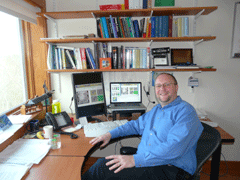
Josef Kellndorfer (Photo: Bruce Gellerman)
GELLERMAN: As we mentioned, the president has chosen John Holdren as his science advisor. Holdren is a physicist by training and a professor of environmental policy at Harvard. Until he took a leave of absence he was investigating the causes and consequences of global climate change.
Holdren also had to step down as the director of The Woods Hole Research Center in Falmouth, Massachusetts.
Woods Hole is an independent institute focusing on environmental science, education and public policy. Living on Earth’s Executive Producer Steve Curwood is on the Center’s Board of Trustees.
While he’s been there many times, I only got my first chance recently when I drove down to do some interviews for this story about using satellites to monitor deforestation and climate change.
So I took out my trusty GPS and promptly got lost. I eventually found Woods Hole. But you can’t always depend on Google Earth, says Josef Kellndorfer, and he should know. He’s an expert in satellite pictures of Earth at the research center.
KELLNDORFER: Google Earth is a beautiful system which we use tremendously even now in science but it’s still in the stages of being a static system where we get maps that are possibly a couple years old.
GELLERMAN: Kellndorfer is an associate scientist at Woods Hole. He uses remote sensing technology to monitor the health of our planet.
KELLNDORFER: I usually describe myself as one of the radiologists on staff and the patient is the Earth.
GELLERMAN: On the corridor walls and offices at Woods Hole Research Center are poster size photos taken from space, showing the patient in exquisite detail.
We stop in front of one particularly spectacular shot of the Amazon Rainforest taken by Landsat, the granddaddy of all remote earth sensing satellites.
KELLNDORFER: You know Landsat has been the workhorse of remote sensing for 30 some odd years.
[LANDSAT SOUNDS]
KELLNDORFER: We’re into the final half minute of the count down now of the Delta II with Landsat 7…t minus 20 seconds..everything go at this time…
GELLERMAN: The Landsat program, began in 1972. The launch of Landsat One put into orbit the first satellite designed to specifically study and monitor the planet’s landmasses…
[LANDSAT SOUNDS “SIX …. FIVE …. FOUR…”]
GELLERMAN: Landsat 7 launched in 1999 is the most recent.
KELLNDORFER: Main engine start and lift off of the Delta II rocket with the advanced Landsat 7 space craft.

Josef Kellndorfer (Photo: Bruce Gellerman)
GELLERMAN: Landsat 7 quit after four years is space, but Landsat 5 is still going strong. This month marks its 25th year of sending pictures of Planet Earth back from space.
Woods Hole Research Center Senior Scientist Scott Goetz says Landsat has created a unique historical archive.
GOETZ: Landsat really changed our worldview I think because it just suddenly we were able to look at maps of land use change and the application of Landsat imagery was just amazing how it became used in just about every science application you can imagine.
GELLERMAN: Landsat has documented the formation of volcanoes, floods, cyclones and earthquakes, even sending photos from space of President Obama’s inauguration.
Now Landsat 5 and Earth orbiting satellites launched by the United States and other countries are going to be given a new job: monitoring climate change. But Yvo De Boer, head of the United Nations Framework Convention on Climate Change fears the satellites may not be up to the task.
DE BOER: Being able to measure what is happening is incredibly important to developing a robust international climate change response. You wouldn’t expect it in this modern day and age but actually our ability to monitor greenhouse gas emissions is relatively weak.
GELLERMAN: The problem is the sensor technology. It’s not just old, it’s old school. Again, Woods Hole scientist Josef Kellndorfer.
KELLNDORFER: One of the Landsat shortcomings is that it’s an optical sensor, so there are regions that you don’t get images for several years because of the cloud cover.
GELLERMAN: Being able to take images through clouds and at night is critical for monitoring the health of the world’s tropical forests trees store carbon, and deforestation and destruction of these vast forests accounts for roughly a fifth of greenhouse gas emissions. That’s where ALOS comes in.
[SOUND OF JAPANESE SATELLITE LAUNCH]
GELLERMAN: Two years ago the Japanese space agency launched a new era in remote sensing systems: ALOS- the Advanced Land Observing Satellite
[SOUND OF JAPANESE SATELLITE LAUNCH]
GELLERMAN: Aboard ALOS is a sensor called PALSAR. It uses radar to take images of earth. Radar’s long wavelengths can penetrate clouds.
There are a number of radar frequencies used in remote sensors. Joseph Kellndorfer uses a mnemonic device to keep track of them.
KELLNDORFER: From long to short wavelengths it’s p-l-c-x. And I call it Peter Loves Claudia’s Xylophone.
GELLERMAN: And remote sensing scientists love radar. Not only can radar space sensors see through clouds, with PALSAR’s powerful system they can see the forest from the trees and the trees through the forest canopy.
KELLNDORFER: Again, in the radar here we see clearly between the 2007 image and the 2008 image this patch of forest has been cut. Just from the color combination of the two signals you see immediately what is popping out. In the red colors what has been deforested.
GELLERMAN (ON TAPE): Boy nothing gets past you.
KELLNDORFER: Not much anymore. Yes we can clearly detect a lot of these dynamics.
GELLERMAN: ALOS can now quickly map the world in a matter of weeks, where before it took a year or more. And two new polar orbiters can do it even faster. They’re equipped with an advanced type of imager that can take high-resolution photos of the planet in a day. Woods Hole Senior Scientist Scott Goetz analyzes the data.
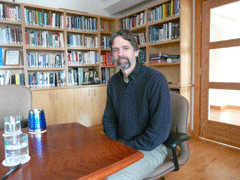
Scott Goetz (Photo Bruce Gellerman)
GOETZ: What you can see is the Amazon basin - you can see logging expansion here and settlers have moved in and you can also see this very large deforestation associated with soy farming.
GELLERMAN: These new space imagers are critical to understanding the causes of climate change and monitoring the damage because under a UN proposed scheme called REDD, Reduced Emissions from Deforestation and Degradation, countries, farmers, ranchers and indigenous groups in rainforests will be compensated for NOT cutting down the forest - keeping the carbon locked in trees. Satellite sensors will reveal how much is there and help establish a baseline to determine if forests are being cut down or destroyed.
Josef Kellndorfer says the orbiting sensors then act as independent, verifiable eyes in the sky to monitor and enforce REDD.
KELLENDORFER: You need that time component, the monitoring component, that’s the beauty of satellite observations that you have time-series that help to detect what the dynamics are of the surface.
GELLERMAN: But to verify what the satellites see from space is really what’s happening in forests, scientists still need people and sensors on the ground. So Woods Hole has begun training people in Congo’s rainforest teaching how to calculate the carbon in trees. Again, Scott Goetz.
GOETZ: And then, of course, what we’re really interested in is taking that to all the other tropical countries making pan-tropical maps of carbon stocks.
GELLERMAN: Is there ever too much information?
GOETZ: I don’t think so. We never seem to get enough.
GELLERMAN: The amount of data from space sensors monitoring the earth is measured in the trillions of gigabits a day and shared internationally.
To coordinate the massive amount of information coming from satellites, ground stations and climate change sensor at sea, the Center for Global Development, NASA and Cisco Systems have just announced a new project called Planetary Skin - fusing the data from all these sensors so the layers can be peeled back by scientists, revealing what’s happening to the planet’s climate.
Nancy Birdsall is president of the Center for Global Development.
BIRDSALL:These investments in information now are absolutely critical now if we’re to have any sort of system at the global level that people in this country and other countries can trust.
[SOUND OF ORBITING CARBON OBSERVER: “… And liftoff of the Taurus rocket with OCO tracking a greenhouse gas of in seek of clues to global warming.”]
GELLERMAN: Space flight, now routine, is still a high-risk venture. Last month NASA’s Orbiting Carbon Observer satellite failed to reach orbit, crashing in Antarctica.
It was a 280 million dollar loss, but what’s at stake from climate change is far greater.
James Fletcher, NASA’s Administrator during the early days of the LANDSAT missions once predicted, “If one space age development would save the world it would be Landsat and its successor satellites.”
Earth does not reveal her secrets easily.
Related link:
The Woods Hole Research Center
[MUSIC: The Ventures “Telstar” from The Ventures (HHO Licensing 1961)]
CO2-Eating Rocks
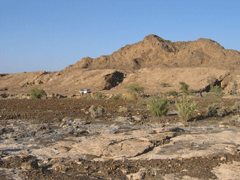
An ultramafic rock deposit in the northern mountains of Oman. (Courtesy of Juerg Matter)
GELLERMAN: Carbon dioxide has the planet between a rock and a hard place - we get needed energy from fossil fuels, yet burning them produces a greenhouse gas that’s causing climate change.
But perhaps the answer lies in the problem: put the gas between a rock and a hard place. Not just any rock - but a type called ultramafic.
Juerg Matter has investigated this ultra-interesting rock. He’s an Associate Research Scientist at the Lamont Doherty Earth Observatory.
Hi Mr. Matter!
MATTER: Thanks for having me.
GELLERMAN: Tell me about ultramafic rock.
MATTER: Yeah, ultramafic rocks are mantle rocks which are usually 25 to 30 miles below surface, and they are rich in magnesium silicate minerals. And actually these magnesium silicate minerals can be used for carbon sequestration. The magnesium is used to carbonate the CO2 into magnesium carbonate minerals.
GELLERMAN: Which is like chalk and limestone, right?
MATTER: Exactly.
GELLERMAN: So it sequesters the carbon dioxide. It changes it.
MATTER: Yeah, that’s true. It changes, you know, the carbon dioxide, which is a gas, into a mineral, which is stable and environmentally benign.
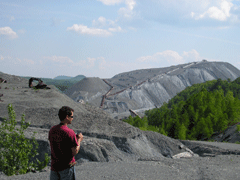
Juerg Matter at the Belvedere Mountain mining site in Vermont (courtesy Sam Krevor)
GELLERMAN: So this would provide, then, a stable sequestration. You wouldn’t have to worry about the gas escaping from a hole in the ground because it wouldn’t be a gas anymore.
MATTER: Exactly. And you know, that’s the big, big advantage in this sequestration option that you produce an environmentally benign calcium or magnesium carbonate mineral, which cannot leak back CO2 back into the atmosphere.
GELLERMAN: Well, how long does this chemical reaction take in nature?
MATTER: Every day it takes place, but it’s, as we could see in Oman on average, you know, these carbonates, you can find in these types of rocks are 26,000 years old. So it’s on geologic time, much faster than we thought before, but it’s not fast enough for our engineered process to really, you know, soak up a lot of carbon dioxide.
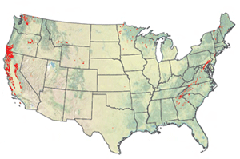
Ultramafic rocks (in red) that potentially could absorb CO2 (courtesy U.S. Geological Survey)
GELLERMAN: So how can we speed up this chemical reaction between the ultramafic rock and CO2?
MATTER: Generally you can grind the rocks to really fine powder. And then you can react the rocks with carbon dioxide on the surface here, like in a cement factory and produce, you know, these carbonate minerals. But you can also think about to inject CO2 into these rocks. And also if you heat up the rocks to 185 degrees, the reaction just takes off and it goes forever, so it’s sustainable. And so, heat speeds up the reaction.
GELLERMAN: Now, we don’t have to drill down, you know, 45 miles into the Earth to do this, do we? Or do we?
MATTER: Oh no, no, no. These rocks are, you know, through tectonic processes these rocks were thrust onto the continental crust because of the mountain forming processes put these rocks on the surface.
GELLERMAN: Well you mention that you can find this type of rock in Oman. Where in the United States is this rock found?

An ultramafic rock deposit in the northern mountains of Oman.
(Courtesy of Juerg Matter)
MATTER: Yeah, in the United States you find, you know, a lot of ultramafic rocks in California, Oregon and Washington State. You will find these rocks also in, you know, along the whole Appalachian Mountain belt. And you also find it in the interior, in Wyoming, Montana, and Minnesota. And a little bit, you know, excuse me in Texas and in the South.
GELLERMAN: How much CO2 could we absorb? I mean we’re pumping out like 30 billion tons a year of the stuff.
MATTER: Yeah, exactly. I mean, you could sequester, you know, the next 500 years of U.S. CO2 emissions. For Oman, itself, and in Oman we have an ultramafic rock body of 350 kilometers long, 40 kilometers wide and 5 kilometers thick. If we would use every magnesium ion in these rocks and convert that to carbonates we would have thousands of years absorption capacity. But, you know, more realistic, is roughly, you know, on a scale of one billion tons of CO2 per year – that’s possible in this type of rocks.
GELLERMAN: So if we had an international trading scheme, where there was really value on CO2, countries that had this type of rock, could make money out of it.
MATTER: Exactly. And that’s why, you know, the Ministry of Commerce of the Sultanate of Oman is interested. You know, they have the biggest ultramafic rock body in Oman and it’s just a black green rock sitting there, but you know it could be used as a source of income.
GELLERMAN: Juerg Matter is an Associate Research Scientist at Lamont Doherty Earth Observatory, part of the Earth Institute at Columbia University. Mr. Matter thanks a lot.
MATTER: Yeah, thanks a lot. It was good talking to you.
Related links:
- Columbia University's Earth Institute and the U.S.G.S. have mapped the ultramafic rock deposits in the U.S.
- The Lamont-Doherty Earth Observatory at Columbia University
[MUSIC: Madrid “Tierra Del Fuego” from Warm Waters (Madrid 2009)]
GELLERMAN: Just ahead – joking the shark to save the seven seas. That’s coming up - on Living on Earth.
ANNOUNCER: Support for the Environmental Health Desk at Living on Earth comes from the Cedar Tree Foundation. Support also comes from the Richard and Rhoda Goldman fund for coverage of population and the environment. ..and from Gilman Ordway for coverage of conservation and environmental change. This is Living on Earth on PRI, Public Radio International.
[MUSIC: Nels Cline: “Prayer Wheel” from Coward (Cryptogramophone 2009)]
Listener Letter
GELLERMAN: Time now to open our mail.
Our story about using federal stimulus funds to build high-tension transmission lines generated quite a bit of response. More than one listener said we didn’t ask the obvious questions: Why do we still allow the lines to be strung through the air anyway? Why don’t we bury them - especially in sensitive scenic areas or those prone to ice and wind damage.
Point taken.
JW Madison – an electrical contractor who heard the same story on KUNM in Albuquerque, New Mexico - asks, “Why don’t we pay more attention to producing power closer to home to lessen the need for long distance transmission lines in the first place? Moving power long distances is expensive, inefficient and sucks up a huge amount of land.”
Jim Cheairs is a transplanted southerner who listens to LOE on KUOW in Seattle. He enjoyed our Home Ground essay about kudzu - and likes the fast growing invasive plant even though it’s taking root all over the country.
CHEAIRS: You know it seems as if folks in the South continuously complain about how kudzu has taken over the landscape yet I hear little regarding the beneficial uses of the plant: for example – it makes a great clothing - it’s used in weaving – we keep a little bit of the root in the kitchen to help with stomach ailments as well as we use it as a cooking thickener.
GELLERMAN: And Jim Cheairs suggests that kudzu might even make a good biofuel.
And talking of plants – our emerging science note about molding coconut husks into car parts and truck liners got quite a response.
Gene Ammarell, an anthropology professor from Ohio, listens to us on his iPod. He says in Indonesia, where he does research, villagers use coconut husks for fuel and compost.
AMMARELL: If villagers were to sell husks to corporations as raw materials for car parts, not only would they have to buy manufactured chemical fertilizers and propane fuel to replace the coconut husks, they would also lose the added value that would go to the processors of the coconut fibers and manufacturers of the parts.
GELLERMAN: Our interview with California’s energy commissioner Arthur Rosenfeld piqued some interest. The Commissioner is an advocate of white roofs and roads - which he says can help cool the planet.
WBUR listener Michael Frishman from Andover, Massachusetts said white roofs could also save cool cash – seems because light colored roofs expand and contract less in the heat - they last longer.
Well, whether it’s about the sky above or the earth below - or anything in between on our show - that intrigues or annoys, let us know by email or phone. You can reach us at comments@ loe.org. Once again, comments@ loe.org. And you can call our listener line, at 800-218-9988. That's 800-218-99-88.
Cartoon with a Message
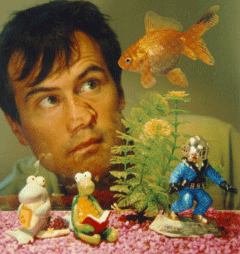
Jim Toomey is an artist and author of the nationally syndicated comic strip Sherman's Lagoon
GELLERMAN: The state of the world’s oceans is serious stuff - fish are becoming scarce - coral is dying - and the seas are filled with plastic flotsam.
No, nothing to laugh at - unless you catch the syndicated newspaper comic, Sherman’s Lagoon. The comic strip features a cast of coral reef critters living on Kapupu Lagoon in the South Pacific.
The creator is cartoonist Jim Toomey. Jim was among those at the recent Blue Vision Summit in Washington, DC, a gathering of 150 organizations that deal with ocean issues - and Jim Toomey joins me from the nation’s capital.
Hi Jim, welcome to Living on Earth.
TOOMEY: Thanks, happy to be here Bruce.
GELLERMAN: So what’s a cartoonist doing at the Blue Vision Summit about the ocean?
TOOMEY: [Laughs] Well, first of all, cartoonists have more time than they know what to do with, so we get involved in all kinds of crazy things. The Blue Vision Summit was a natural connection to my interests in my comic strip, because my comic strip is set under water, and it’s got a lot of the same characters that we’re trying to save at the Blue Vision Summit. The Blue Vision Summit’s all about bringing together a wide variety of non-profits and government folks and academics and cartoonists and artists to discuss ocean conservation.
GELLERMAN: Well, let’s talk about your creation here a little bit and how it fits into the ocean.
TOOMEY: Sure.
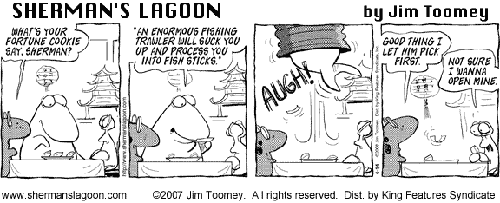
Sherman's Lagoon is meant to be entertaining but Jim Toomey does sometimes address serious issues
GELLERMAN: There’s Sherman, your dim-witted shark. He eats gum off the seats of movie theaters.
TOOMEY: Yeah, well, he’s kinda of a scavenger. He’s – I made him my main character because he’s naïve and he’ll pretty much say anything, which is great for a main character, even though he’s not the brightest light bulb in the box.
GELLERMAN: [Laughter] His side kick, though, Fillmore, the sea turtle …
TOOMEY: Fillmore’s a sea turtle, and he’s sort of the rational half of the two. He’s the Hardy of the Laurel and Hardy, if you will. And Sherman will say anything and do anything, and Fillmore kinda keeps him in check. I try to round out the cast with a couple of other characters like Hawthorn the irascible hermit crab. He’s always thinking up a new business plan and trying to swindle people out of their hard earned money. And there’s Sherman’s wife Megan who’s kind of an overbearing, but sensitive female shark. And then there’s Earnest who is kind of a nerd, a little fish who surfs the internet and poses as a human on the internet, and he causes all kinds of problems on the dirt side of the world.

Jim Toomey is an artist and author of the nationally syndicated comic strip Sherman's Lagoon
GELLERMAN: The character who interests me is Thorton, the polar bear …
TOOMEY: [Laughter]
GELLERMAN: .. who basically hitches an iceberg and winds up in the South Pacific lagoon.
TOOMEY: He’s a lot of people’s favorite character. And a lot of these characters are just little parts of my own character. And as a cartoonist I get a lot of grief for having a lot of spare time and doing fun things like this Blue Vision Summit. And Thorton’s always on vacation, he’s always just laying on the beach. And polar bears don’t really hibernate, but this one he hibernates on the beach, this fictional beach were my lagoon is set, pretty much all summer and then – or all winter, I’m sorry – and then he goes off to various places to live his real life. And couple of times I’ve taken him back to the north pole where I’ve done some cartoons on the polar ice melting up there.
GELLERMAN: Yeah, I was going to ask you – you’ve got a degree in environmental management. How would Thorton and the rest of your crew, you know, fare with global warming and the rising sea level and the acidification of the ocean?
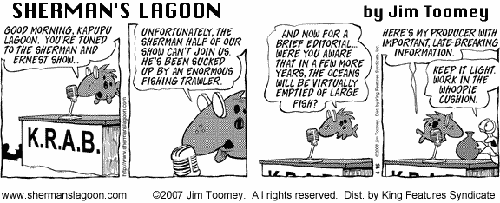
(Courtesy of Jim Toomey)
TOOMEY: Right well, they’re not faring well in the real world and what I’m trying to do without trying to beat my readers over the head with an environmental stick is to make them aware of that. So when I did bring Thorton the Polar Bear up back to his home, I had him swimming around, I had him looking for ice and floating around on a very small iceberg and so forth. So, in that kind of subtle way, I’m making readers aware that there are large problems out there.
GELLERMAN: So is the art of making a comic subversive …
TOOMEY: [Laughter]
GELLERMAN: … that is you know, kind of slipping in that environmental message.
TOOMEY: Well, subversive is kind of a strong word, but maybe subtle. I’m cartoonist first and an environmentalist second. My job, if you want to call it a job, is to entertain, and if I stop entertaining then I lose my readership, and if I lose my readership, then I – it doesn’t matter what my message is, nobody’s gonna read it. So my priority is to make readers come to the paper and read the strip, and then I can slip an environmental message in there. Part of the mission of the cartoon is to make people aware that there’s a lot more complexity under that surface. And sometimes that doesn’t come through in the nature documentaries and the books and so forth. The actual animal behavior that I like to weave into the comic strip. For instance, Fillmore the Sea Turtle, he’s a green sea turtle, and he goes to this place called Ascension Island where real green sea turtles go to lay eggs. So I weave those real marine biology nuggets into the comic strip and by the end of reading a series hopefully you’ve picked up a thing or two about the environment and about the science of the ocean.
GELLERMAN: Where do you get your ideas from? Do you read the science journals or just the news about environmental issues in the ocean and try to incorporate them into the cartoon?
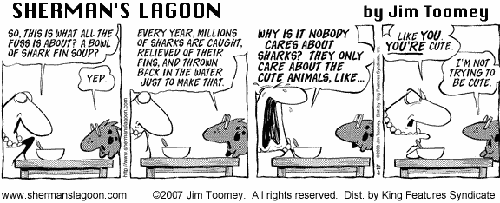
(Courtesy of Jim Toomey)
TOOMEY: Sure, I do a lot of that. And part of the reason I got the masters degree in environmental management was to build a better foundation to understand some of those articles at a deeper level than your average person. So I try to distill it down to some simple messages because you can’t really get too complicated, especially with a comic strip, you have to distill it down to a very simple message.
GELLERMAN: So you can have a serious message in this comic.
TOOMEY: Well, yeah, maybe not a message, but a serious fact or two. In the end I hope to make people laugh, but in a way that provokes their thought. I ran a Sunday comic strip a while back that spoke to sustainable seafood where there was Sherman the Shark and then there was Hawthorn the Hermit Crab. And Hawthorn was pointing out the different fish swimming by and how some fish are okay to eat in a seafood restaurant and some aren’t and you can eat this snapper …
GELLERMAN: [Laughter]
TOOMEY: … and you can’t eat this salmon and so forth and so forth. And by the second to last panel, a human snorkler went by and Hawthorn says to Sherman “you can eat as many of those as you want.”
GELLERMAN: [Laughter] I knew where you were going. [Laughter] I saw the panel.
I want to ask you about your musical, Sherman’s Lagoon is…
TOOMEY: Yeah, sure.
GELLERMAN: … now in the theater.
TOOMEY: It premiered last year. And it’s – knock wood – destined for a regional theater or two. And it’s fantastic. I can say that because I didn’t have a lot to do with the music part of it, and the music just knocked my socks off.
GELLERMAN: Well Jim Toomey, I really enjoyed talking with you.
TOOMEY: It was a pleasure to be here Bruce.
GELLERMAN: Cartoonist Jim Toomey is the creator of the newspaper comic strip, Sherman’s Lagoon.
Related links:
- Sherman's Lagoon Home Page
- Blue Vision Summit
[MUSIC: Various Artists “Welcome To The Lagoon” from Sherman’s Lagoon: The Musical (Twoomey Music 2009)]
Worm Grunters
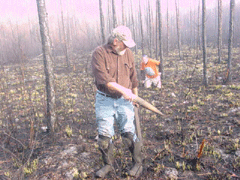
Gary and Audrey Revell go worm grunting in the Apalachicola Forest. (Photo: Warren Duzak)
GELLERMAN: They say the early bird catches the worm, but one Florida family gives the bird a run for its money.
Peter White got down and dirty to bring us this story.
WHITE: It’s just after sunrise in the Apalachicola National Forest in Northern Florida. A hazy mist hangs in the air—and there’s dew on the ground. A hundred foot pine trees stand like soldiers on parade.
Just another day at the office for Gary and Audrey Revell and their 33-year-old son, Snap.
SNAP REVELL: Alright Mom, let’s do it.
[SOUND OF WALKING]
WHITE: Gary and Snap each carry a stob – a hardwood stake about two feet long sharpened to a point. Their other tool is a flat steel bar called a rooping iron. An inch thick, it weighs ten pounds and is tapered at one end to fit your hand.
[SOUNDS OF POUNDING AND GRUNTING]
WHITE: They pound their stakes into the ground with the flat of the iron.
[SOUNDS OF POUNDING AND GRUNTING]
WHITE: And make them vibrate by rubbing the iron back and forth across the top of the stob. What they’re doing is hunting for worms.
[SOUNDS OF POUNDING AND GRUNTING]
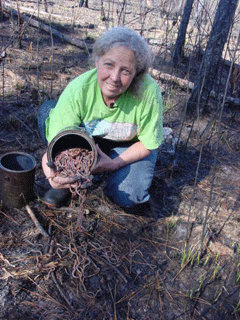
Audrey Revell’s bucket overfloweth with worms. (Photo: Warren Duzak)
Gary REVELL: Once you make the right music, they’ll go to dancing for you. Hopefully, I’m doing it. [laughter]
WHITE: The Revell clan has been harvesting worms this way for generations. Some call it worm grunting. They call it rooping.
GARY RVELL: That’s just a term we came up with. Some people call it scrub bait, scrubbing the stob…grunt..grunt worms..maybe some would say charming or fiddlin’ whatever.
WHITE: By whatever name - it works.
I can feel the vibrations under my feet. Out of the ground come earthworms by the dozens. I can’t believe my eyes.
WHITE: There’s one, there’s another, there’s another.
Audrey crouches low and moves quickly, snatching up worms as they leave their burrows. Her gallon bucket is soon full.
AUDREY REVELL: That’s 500 worms. That’s a full can.
WHITE: On a good day, one grunter can keep two collectors busy. Some grunters use smaller stakes and lighter irons, says Gary.
GARY REVELL: They make a high pitch…(he mimics sound)….while ours has got a rumble to it. They both work.
WHITE: Gary and Snap read the ground like a map: small holes and worm castings—the presence of birds are good signs. The white sand mounds made by crawfish tell them the ground is low and moist here. The weather and even the phase of the moon affect how well they will do.
[SOUNDS OF POUNDING]
WHITE: Snap pounds his stob about a foot into the ground - and begins to draw his iron across the top, playing it like a giant fiddle. Then he pounds again. The tone changes as the point of the stob reaches down to the dense sand or pan below the topsoil.
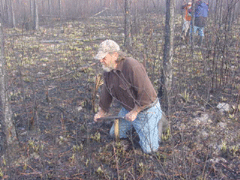
Gary Revell uses his tools of the trade. (Photo: Warren Duzak)
[SOUND OF ROOPING]
SNAP REVELL: Normally when you notice the bait start surfacing is when it gets into that hard pan and then the vibration travels a little better.
[SOUND OF ROOPING]
WHITE: The shorter the stob gets the higher the pitch. It sounds like a raspy saxophone solo. But the longer the stob the lower the pitch.
GARY REVELL: Apparently these are more Beethoven type. [laughter]
WHITE: Gary lets me have a go at it. It’s definitely harder than it seems.
He gets ten worms to every one I coax out of the ground. But why does it work? That’s what biologist Ken Catania of Vanderbilt University was determined to find out.
CATANIA: When you think about all the predators and things that like to eat earthworms, you would imagine that they should go down when there is a vibration or something digging or some sort of disturbance on the ground. But instead they’re going the wrong way, they’re streaming out of the ground. So that’s sort of an irresistible mystery, why would they do that?
WHITE: He got a tip from a slim volume about earthworms written by Charles Darwin in 1881.
CATANIA: In that book he pointed out that ‘It has often been said that if the ground is beaten or otherwise made to tremble, worms believe they are being pursued by a mole and leave their burrows. And I thought that was just a great clue to what might be going on.
WHITE: So Catania went down to the Apalachicola Forest to meet the Revells and study their technique. The first thing he discovered was that lots of eastern moles live in the forest. Next, he measured the vibrations made by the Revells and the vibrations made by digging moles. They overlapped. Then he put the worms and moles together to see what happened.

Gary and Audrey Revell go worm grunting in the Apalachicola Forest. (Photo: Warren Duzak)
CATANIA: It was amazing to see. So as soon as that mole dug down into the dirt, up came the earthworms, sort of streaming out of the ground in front of it. Basically, looking like they were running, if you could describe a worm as running. They were moving about as fast as a worm could go.
WHITE: Why up and not down? Because moles won’t chase worms above ground for fear of becoming prey themselves. Earthworms come out of the ground to escape their worst enemy, only to be caught by the Revells. Biologists call this hunting strategy exploitive mimicry. It is used by a rare predator—in this case a worm-grunter who takes advantage of a prey’s escape response to its main predator. Wood turtles and seagulls do the same thing the Revells do. They tap the ground pretending to be a mole and the worms come up.
[GRUNTING]
WHITE: Back in the forest, the Revells have collected six cans of worms in about three hours.
GARY REVELL: There’s a whole lot of grunting going on out here, that’s for sure.
WHITE: The sun has climbed overhead. It’s time to go back to the shop and count them out into little blue containers, which they sell to bait shops.
[SOUNDS OF PUTTING CANS INTO TRUCK. “SET ‘EM IN THE SHADE”]
WHITE: The Revells live pretty much off the grid, but wouldn’t put it that way. Rather, outside of town where it’s quiet and the living is easy.
GARY REVELL: It’s totally different and once you’re accustomed to this type of living, it’s hard to cope with any other.
WHITE: People drop by to chew the fat, and if the Revells aren’t home, they count their own worms and leave the money in a box in the bait shop. Next month the Revells will give demonstrations at the annual worm grunting festival in the small town of Sopchoppy, Florida. They’ll be there with the stakes, and irons, and thousands of worms they’ve brought from the forest just for the occasion.
For Living on Earth, this is Peter White.
Related links:
- Professor Ken Catania’s research paper on worm grunting
- Worm Gruntin’ Festival in Sopchoppy, Florida
[MUSIC: Tony Burrello “There’s A New Sound” from The Sound Of Worms (Fish and Rats) (Spunkey Monkey Music 1995)]
GELLERMAN: On the next Living On Earth: California counts the carbs - putting vehicle fuels on a low-carbon diet.
EGGERT: To achieve our 2050 goals for greenhouse gas emissions 80 percent below 1990 levels, really requires that we completely transform and de-carbonize our transportation energy system.
GELLERMAN: California, climate change and the fuels of the future - next time on Living on Earth.
[SOUNDS OF THE WIDEN FEN]
GELLERMAN: We leave you this week at the Widen Fen, in Cambridgeshire England.
[SOUNDS OF THE WIDEN FEN]
GELLERMAN: It’s not quite spring yet at the National Nature Reserve but the gang’s all here. Redshanks, coots, and lapwings are just a few of the fine feathered friends who sing, wing, and strut their stuff at this wetland. It’s one of the most important in all of Europe.
[SOUNDS OF THE WIDEN FEN]
GELLERMAN: Richard Margoschis recorded these birds gone wild - for the British Library National Sound Archive CD, Wild Britain.
Living on Earth is produced by the World Media Foundation. Our crew includes Ashley Ahearn, Bobby Bascomb, Eileen Bolinsky, Ingrid Lobet, Helen Palmer, Mitra Taj and Jeff Young, with help from Sarah Calkins and Marilyn Govoni. Our interns are Lindsay Breslau, Liz Gross and Christine Parrish. Jeff Turton is our technical director. Alison Lirish Dean composed our themes. You can find us anytime at loe.org. Steve Curwood is our executive producer.
I’m Bruce Gellerman. Thanks for listening.
ANNOUNCER1: Funding for Living on Earth comes from the National Science Foundation, supporting coverage of emerging science, and Stonyfield Farm: organic yogurt and smoothies. Stonyfield pays its farmers not to use artificial growth hormones on their cows. Details at stonyfield.com.
Support also comes from you our listeners, the Ford Foundation, the Town Creek Foundation, and the Oak Foundation supporting coverage of climate change and marine issues; The Rockefeller Foundation and its Campaign for American Workers. More at rock found dot org. and Pax World Mutual Funds: socially and environmentally sustainable investing. Pax World: for tomorrow. On the web at paxworld.com.
ANNOUNCER2: PRI, Public Radio International.
Living on Earth wants to hear from you!
Living on Earth
62 Calef Highway, Suite 212
Lee, NH 03861
Telephone: 617-287-4121
E-mail: comments@loe.org
Newsletter [Click here]
Donate to Living on Earth!
Living on Earth is an independent media program and relies entirely on contributions from listeners and institutions supporting public service. Please donate now to preserve an independent environmental voice.
NewsletterLiving on Earth offers a weekly delivery of the show's rundown to your mailbox. Sign up for our newsletter today!
 Sailors For The Sea: Be the change you want to sea.
Sailors For The Sea: Be the change you want to sea.
 The Grantham Foundation for the Protection of the Environment: Committed to protecting and improving the health of the global environment.
The Grantham Foundation for the Protection of the Environment: Committed to protecting and improving the health of the global environment.
 Contribute to Living on Earth and receive, as our gift to you, an archival print of one of Mark Seth Lender's extraordinary wildlife photographs. Follow the link to see Mark's current collection of photographs.
Contribute to Living on Earth and receive, as our gift to you, an archival print of one of Mark Seth Lender's extraordinary wildlife photographs. Follow the link to see Mark's current collection of photographs.
 Buy a signed copy of Mark Seth Lender's book Smeagull the Seagull & support Living on Earth
Buy a signed copy of Mark Seth Lender's book Smeagull the Seagull & support Living on Earth

